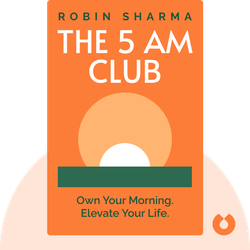Try Blinkist to get the key ideas from 7,000+ bestselling nonfiction titles and podcasts. Listen or read in just 15 minutes.
Start your free trial
Blink 3 of 8 - The 5 AM Club
by Robin Sharma

The Classic that Moved the Environmental Movement
Unless you enjoy studying insects, you probably look at bugs as an unwanted nuisance. This can be true for farmers as well, many of whom are eager to rid their land of crop-eating pests.
So, in the years following WWII, many synthetic poisons were created to combat these pesky bugs.
The poisons that emerged during this period were a byproduct of the work WWII scientists were doing in the field of chemical warfare. As certain chemicals from war were discovered to also be lethal to insects, chemical pesticides were developed to target what we deem to be “pests,” including insects, weeds and rodents.
Over 200 chemicals were developed in the period between the mid-1940s and the 1960s. And during this time, pesticide production skyrocketed to five times its previous rate; in 1947, we produced between 124,000 to 259,000 pounds of pesticides, but by 1960 we were up to 637,000 to 666,000 pounds.
These chemically manufactured poisons were also far deadlier than the ones used in the past.
Earlier forms of pesticides used organic chemicals like arsenic, a highly toxic mineral that remained a basic ingredient in a number of weed and insect killers in the early 1960s.
But studies showed that even arsenic has toxic, carcinogenic side-effects. Areas that have been contaminated by arsenic have caused sickness or death in a variety of animals, including horses, cows, goats, pigs, deer, fish and bees.
The chemical compounds that followed, however, would prove to be even more dangerous.
This is especially true for dichloro-diphenyl-trichloro-ethane, a popular ingredient in pesticides that is better known as DDT. Though it was first synthesized by a German chemist in 1874, its life as an insecticide didn’t begin until 1939.
Modern pesticides like DDT are used in the form of sprays, dusts and gases – and once it enters its target’s body, in whatever form, it causes insidious and often deadly damage.
These chemicals destroy enzymes that protect the body, prevent oxidation, cause various organs to malfunction and infect cells, slowly causing irreversible and malignant damage.



Silent Spring (1962) is about humanity’s misguided attempts to control nature through the use of chemical pesticides. Find out how our using manufactured poisons to kill unwanted pests disrupts the delicate balance of nature and threatens our very existence. Ultimately, these poisons have the power to destroy the environment, infect the food we eat and contaminate our very lives.
They should not be called insecticides, but biocides.

It's highly addictive to get core insights on personally relevant topics without repetition or triviality. Added to that the apps ability to suggest kindred interests opens up a foundation of knowledge.
Great app. Good selection of book summaries you can read or listen to while commuting. Instead of scrolling through your social media news feed, this is a much better way to spend your spare time in my opinion.
Life changing. The concept of being able to grasp a book's main point in such a short time truly opens multiple opportunities to grow every area of your life at a faster rate.
Great app. Addicting. Perfect for wait times, morning coffee, evening before bed. Extremely well written, thorough, easy to use.
Try Blinkist to get the key ideas from 7,000+ bestselling nonfiction titles and podcasts. Listen or read in just 15 minutes.
Start your free trial
Blink 3 of 8 - The 5 AM Club
by Robin Sharma